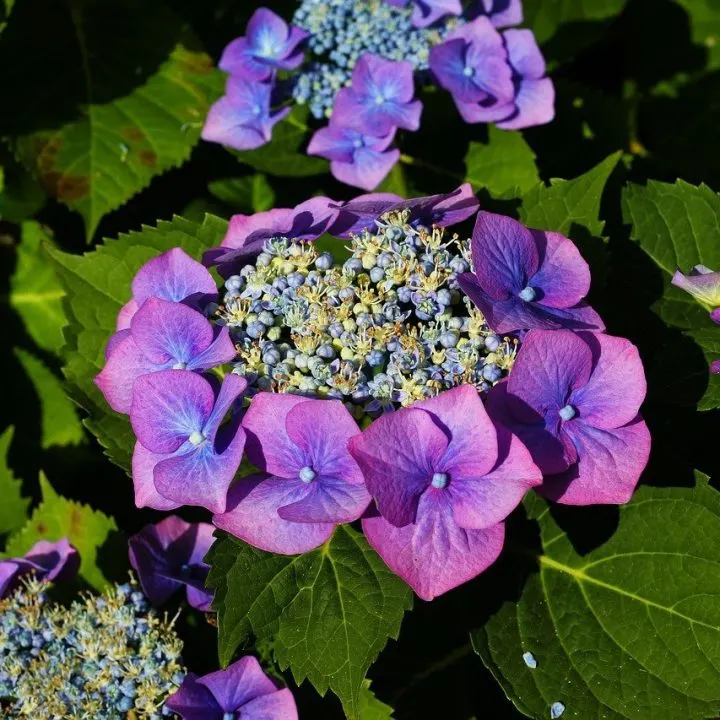Whenever we share this guide to hydrangea pruning on social media, there are always those who say that hydrangeas should only be pruned in spring, while others say they should only be pruned in fall.
Hydrangeas are a common landscape plant, and for good reason; they’re gorgeous and they can grow in full sun to partial shade.
Known for their large, colorful clustered blossoms, Hydrangeas have pronounced, deep green foliage and are generally free from pests and disease. Except for requiring a lot of water, hydrangeas are fairly low maintenance.
There is one thing that sets a beautiful hydrangea apart from a spectacular hydrangea: pruning.
But When Should Hydrangeas Be Pruned?
Should hydrangeas be pruned in fall, winter or spring?
When to prune Hydrangeas depends on the type of hydrangea bush as well as the hardiness zone. Some should indeed be pruned in fall through late winter, before spring buds. Others, should be pruned in spring.
Hydrangeas respond to pruning by producing an abundance of dense growth, which will promote heavy blooming. Prune bigleaf, vining, and oakleaf hydrangeas after blooming in fall or winter. Prune limelight, peegee, and smooth hydrangeas before blooming in early spring.
Exceptions on When to Prune
The bottom line is that if you’re pruning yours at a different time than outlined in this guide, and it’s working for you, then keep on doing what you’re doing! Beyond that, you’ll also need to take into account your climate. As one reader expresses here.
Pruning Hydrangea Macrophylla in Cold Climates
Regarding autumn pruning of macrophylla, Sally Manthei says:
“In the Midwest, the spring is the time to prune back Hydrangea macrophylla species and Hydrangea arborescens species!
Here in zone 4b (southeastern Wisconsin) the time to prune Hydrangea macrophylla species is after mid April. This timing guarantees any viable buds lasting the winter can be preserved. Pruning cuts then should be done above last viable leaf bud on each stem.“
~Sally Manthei
Okay! Thanks, Sally!
Now…ready?
Let’s get snipping!
What is Pruning?
Pruning is the selective removal of plant material.
Benefits of Pruning Plants
There are multiple reasons to prune plants. Pruning helps to:
- Improve air flow
- Stimulate new growth
- Improve bloom density
- Direct and shape new growth
- Remove dead and diseased wood
- Expose structural or colorful branches
- Improve the general health of the plant
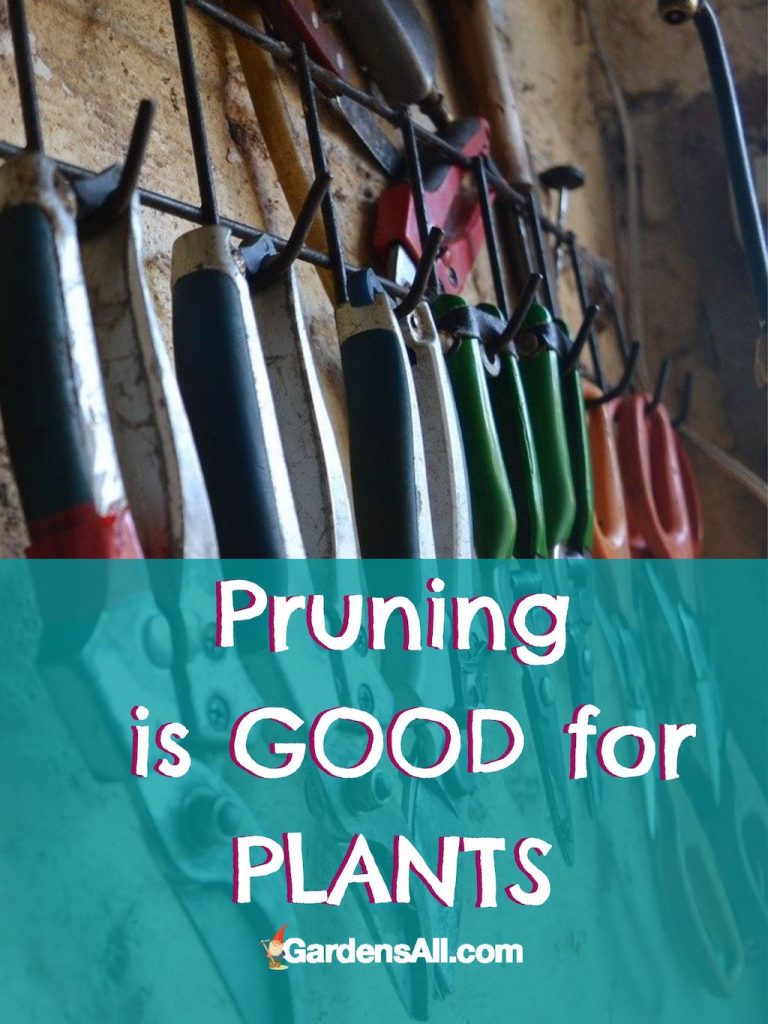
What Are Meristems?
Plants have growth points called meristems. These meristems are clusters of cells that have the potential to grow into multiple plant tissues.
Leaf buds are an example of a meristem. Under normal circumstances, leaf buds will produce leaves.
However, if you cut off a branch directly above a leaf bud, then it can trigger the meristem to regrow stem tissue. This new stem tissue will grow at an angle consistent with the angle of the leaf bud.
Hydrangeas Have Opposite Leaf Orientation
Opposite leaf orientation means that the leaf buds are in pairs along the stem. If you prune back to a pair of leaf buds, then you could have two smaller stems grow back in place of the leave bud which creates a fuller appearance.
When plants grow multiple new stems, they also produce multiple new flower buds. Therefore, creating a dense shrub also maximizes bloom potential.
Roots also have meristems. When you prune away topgrowth, it sends a message to the plant that it is under stress. The roots respond by digging deeper into the soil to access more water and nutrients.
So, pruning triggers roots to grow deeper, and it triggers topgrowth to grow fuller. This improves overall health, appearance, and bloom density.
Basic Pruning Cuts
Although there are many different reasons to prune a plant, the basic pruning cut remains the same.
- Identify the point on the stem where you want to make the cut (a meristem), which could be at:
- the base of the plant
- the joint (or crotch) of two branches
- a leaf bud
- Make an angled cut just above the bud or joint you want to preserve:
- make a cut at the base of the plant slightly above soil level
- cut at the joint of two branches at the same angle as the main branch
- Make the cut at a leaf bud at the same angle as the bud
- Cut close to the base, joint, or bud to promote healing:
- Long stubs will rot or crack because they are too far from the meristem to heal
The One Third Rule of Pruning
Pruning creates stress intentionally to promote a flush of topgrowth and root growth. However, there is a point where the stress becomes detrimental to the plant.
The 1/3rd rule is a simple way to keep your cuts in check.
Do not remove more than 1/3rd of healthy plant material in one pruning session.
The 1/3rd rule does not apply to dead or diseased wood. You should always remove 100% of broken, rotten, or rubbing branches.
Step back from the plant every few cuts to look at the overall shape and how much material you have removed. Don’t remove more than 1/3rd, but don’t be shy.
Make aggressive, strategic cuts that promote air flow in the center of the plant while promoting new branches on the exterior of the plant. This will allow you to remove quite a bit of plant material while creating a full appearance.
Hydrangea Inflorescence
Inflorescence is the botanical term for the entire flower head of a plant. This includes all parts of the floral arrangement on a plant, such as the stems, stalks, bracts and flowers, as well as the process of flowering.
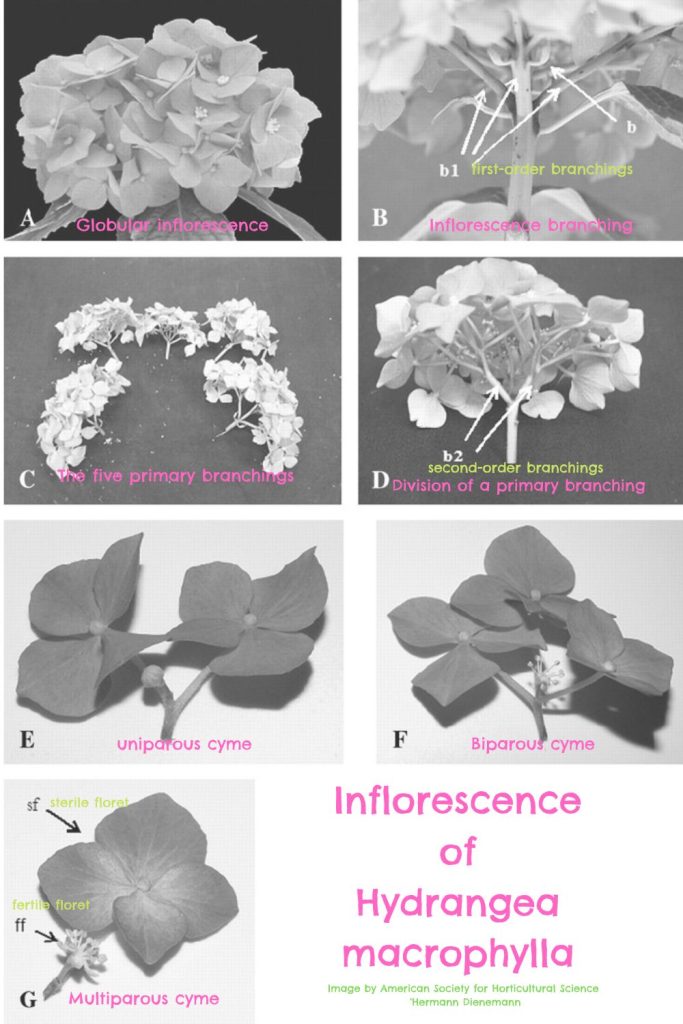
Hydrangea Pruning Tools
If you prune in the spring, you may cut into dense, woody stems. If you prune in the summer, you will probably cut into green, fleshy stems.
Either way, a good set of pruning shears should be the only tool you need.
Utility Scissors
Coleman, master gardener with GardensAll, also uses Fiskars multipurpose garden shears (utility scissors) for lighter pruning of thin stems, stalks and blossoms. In fact, these are usually in one of Coleman’s cargo pockets. The end point is blunted so they don’t poke through. Very clever design!
Coleman says that they can slip into his pruner holster alongside his Felcos pruners, but he’s doesn’t do it out of concern for about metal to metal friction causing dulling, plus it stretches out the holster.
Bypass Pruning Shears
Bypass pruning shears are the most effective hand pruners.
These pruning shears have two blades that pass by each other like scissors when they make a cut. This helps to ensure a clean cut, which prevents infection.
Anvil Pruning Shears
Anvil pruning shear will work on hydrangeas, but they are more likely to cause infection.
These pruning shears have one blade on the upper jaw and a flat lower jaw. The blade cuts through the stem while the lower jaw applies pressure.
Although anvil pruners require less effort to get through thick branches, they are more likely to crush, rip, or tear plant material and cause infection.
Hydrangea stems are not dense enough to merit anvil pruners.
Hedge Pruning Shears
Hedge pruning shears will destroy hydrangeas.
Generally, hedge pruners are intended to shape hedges, which have an extremely dense growth habit. Hedge pruners make it impossible to make sharp, calculated cuts on open shrubs like hydrangeas.
Regardless of the pruning shears you choose, always clean your tools between plants.
How to Clean Pruning Tools – Homemade Cleaning Solution
Mix one part bleach or rubbing alcohol with nine parts water. Let pruners soak for 2 minutes and dry completely.
RELATED: How to clean rusty for tools
Pruning Big Leaf Hydrangea
Bigleaf hydrangeas change color according to the pH of the soil. Blue flowers indicate acidic soils, and pink flowers indicate alkaline soils. White flowers indicate a neutral soil, although some species only show white blooms.
Bigleaf hydrangeas bloom on old wood. This means that flower buds will develop on mature growth from the previous season.
Prune bigleaf hydrangeas after the blooms fade in late summer or early fall and the plant has sent up new shoots. If you prune too late in the fall or too early in the spring, you will cut off most of the developing flower buds.
Note: mountain hydrangeas are pruned like bigleaf hydrangeas.
Step-By-Step Bigleaf Hydrangea Pruning
4 goals for pruning bigleaf hydrangeas:
- Remove dead/diseased wood
- Improve airflow
- Increase bloom density
- Create a uniform shape
First, remove dead and diseased wood.
- Find broken, split, rotten, moldy, dead, or weak branches
- Follow the branch back to a healthy spot on the stem
- Make a clean, angled cut in the healthy tissue to remove the dead or diseased tissue
- If the stem is dead or diseased down to the base, make a clean, angled cut just above soil level.
Second, remove plant material at the center of the shrub.
- Identify branches and leaves that stick out from the center of the shrub
- Follow the branches and leaves back to the main stem
- Make a clean, angled cut to remove leaves and branches
- Do not remove too many main stems from the center of the plant, or else it will reduce blooms the following season
Third, remove plant material to encourage new growth.
- Step back from the shrub and look at the plant from all angles
- Identify branches on the perimeter of the shrub that can be trimmed to enhance the overall shape
- Make an angled cut above a leaf bud that points out from the shrub
- Continue to trim the shrub until you have removed close to 1/3rd of the total healthy plant tissue
Water your hydrangea after you prune to help reduce stress and promote a flush of new growth.
Fall Hydrangea Pruning Video
This is a very helpful guide to pruning hydrangeas in fa.. yet brief video how to by Garden Time.
Pruning Climbing Hydrangea
Climbing hydrangeas are vigorous once they are established.
These versatile vines will climb trees, fences, arbors, trellises, and even sheds. You can also grow them as a groundcover.
Climbing hydrangeas bloom on old wood. Prune these vines in late winter to promote blooms the following spring.
Step-By-Step Climbing Hydrangea Pruning
Climbing hydrangeas are vines, so the overall goals are different than for shrubby species:
- Remove dead and diseased wood
- Train vines to cling to support structure
- Cut vines to increase blooms
Climbing hydrangeas should be pruned in late winter or early spring.
First, remove dead and diseased wood.
- Find broken, split, rotten, moldy, dead, or weak vines
- Follow the branch back to a healthy spot on the vine
- Make a clean, angled cut in the healthy tissue to remove the dead or diseased tissue
- If the vine is dead or diseased down to the base, make a clean, angled cut just above soil level
Second, cut back vines that have grown away from the support structure.
- Find vines that have grown away from the support structure
- If possible, attach them to the support structure
- If that doesn’t work, follow the vine back to a point where it is firmly attached and make a clean, angled cut to remove the stray plant material
Third, cut back small branches and vine tips to promote a flush of new growth in spring.
- Step back from the vine and look at it from all angles
- Identify branches that stick out beyond the overall form
- Make an angled cut back to a leaf bud to trim branches
Climbing hydrangeas are a shade tolerant, vigorous growing plant that rarely needs more than a light pruning to keep the overall shape in check.
You can see a video of ours and read more about climbing hydrangeas here.
Pruning Oakleaf Hydrangea
Oakleaf hydrangeas have a unique, oak-shaped foliage.
Oakleaf hydrangeas bloom on old wood. Flower buds for the following season begin to form almost immediately after flowering. This means you have a small window to prune immediately after blooms fade in the summer.
Oakleaf hydrangea changes color in the fall, and when the leaves drop, they reveal beautiful, textured stems.
Step-By-Step Oakleaf Hydrangea Pruning
There are 4 goals for pruning oakleaf hydrangeas:
- Remove dead and diseased wood
- Promote air flow
- Increase bloom density
- Showcase bark
First, remove dead and diseased wood.
- Find broken, split, rotten, moldy, dead, or weak branches
- Follow the branch back to a healthy spot on the stem
- Make a clean, angled cut in the healthy tissue to remove the dead or diseased tissue
- If the stem is dead or diseased down to the base, make a clean, angled cut just above soil level
Second, remove plant material at the center of the shrub.
- Identify branches and leaves that stick out from the center of the shrub
- Follow the branches and leaves back to the main stem
- Make a clean, angled cut to remove leaves and branches
- Do not remove too many main stems from the center of the plant, or else it will reduce blooms the following season
Third, remove plant material to encourage new growth and showcase bark.
- Step back from the shrub and look at the plant from all angles
- Identify aesthetically-pleasing branches
- Prune plant material away from the bottom of the shrub to reveal the bark/branches
- Identify branches on the perimeter of the shrub that can be trimmed to enhance the overall shape
- Make an angled cut above a leaf bud that points out from the shrub
- Continue to trim the shrub until you remove close to 1/3rd of the total healthy plant tissue
Oak Leaf Hydrangea Video
You can find more info and a video on oak leaf hydrangeas here.
Pruning Smooth, Peegee, & Limelight Hydrangeas
These hydrangea species all bloom on new wood, so the pruning timing and style is slightly different.
Prune smooth, peegee, and limelight hydrangeas in early spring before flower buds form.
Follow the same steps for pruning bigleaf hydrangea, except you can prune back as much old wood as necessary.
Make lots of small trims to promote an abundance of flower buds.
Deadheading Hydrangeas
Deadheading is the removal of dead or dying flowers.
All hydrangea species benefit from deadheading.
During the blooming period, shrubs will expend large amounts of energy into flower production. If these flowers are allowed to die and remain (or persist) on the shrub, then the shrub will stop creating as many new blooms.
However, if you cut off the blooms as they begin to fade, the shrub will put a burst of energy into developing new flower buds. This increases the blooming period as well as the amount of flowers on the shrub. Plus, it removes unsightly dead flowers.
Deadhead with the same basic pruning cut. Follow the flower stem down to a pair of leaf buds, and make an angled cut directly above them.
Stop deadheading hydrangea blossoms near the end of the blooming period if you want flowers to persist through the fall and winter.
In fact, there is some conflicting information by experts as to whether it’s best to clip off old hydrangea blossom or not. We like to experiment to determine for ourselves, especially when there’s differing opinions on the same thing.
So If you have two similar bushes, you might decide to experiment by deadheading one hydrangea but not the other. It can be fun to observe the differences in each plant thereafter, plus you’ll have some blossoms for fall decorations indoors plus those left on the plant for rustic decor on the outdoor shrub.
Vigorous Growers That Are Easy to Care For
Hydrangeas are vigorous plants that thrive with little to no pruning, but they are also very forgiving for newbies testing their pruning skills.
Remember: you don’t have to prune the entire shrub in one day. If you’re worried about taking off too much, take a few days to step away and come back with fresh eyes.
Hydrangeas go through several transformations through the seasons. From blossoms in spring that change color (depending on the variety) and shape as they move into full bloom and color in summer, to delightful dried blossoms in fall that are popular for use in floral arrangements.
Dried hydrangeas left on the plant provide additional landscape beauty through fall and even in winter in some zones. Below is a picture of a single stemmed big leaf hydrangea, Hydrangea macrophylla, with dried blossoms in a winter landscape. This one popped up on it’s own in my mother-in-laws yard next door, so it’s sure to be the offspring of some of our shrubs.
You may also be interested in this article on pruning a Rose of Sharon if you have any hibiscus plants.
You can also cut off the dead blooms and make a wreath with them, spray them with hairspray once you are finished making the wreath they last a long time!
~Karen Benke, reader contribution
What to Do with Dried Hydrangea Flowers?
Hydrangeas make beautiful floral arrangements, both fresh and dried. So when it’s time to prune your hydrangeas is a great time to cut blossoms to enjoy indoors.
Uses for Dried Hydrangea Flowers
- cut flowers for vases in:
- clusters
- single stems
- wreaths
- bouquets
Dried hydrangeas are actually beautiful and are used like cut flowers in vases without water, and in wreaths.
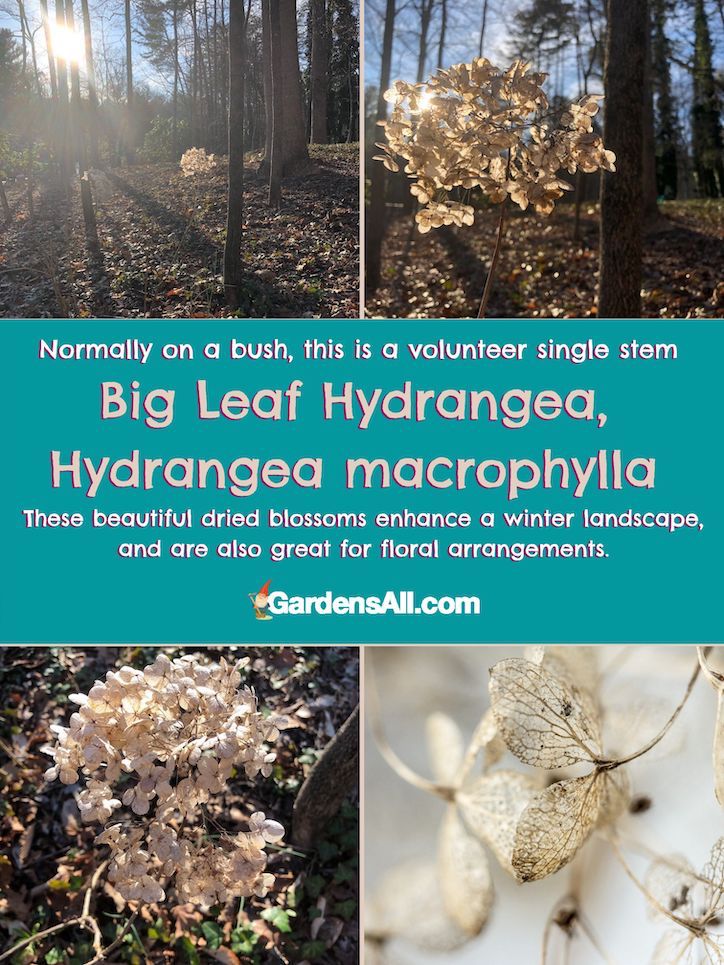
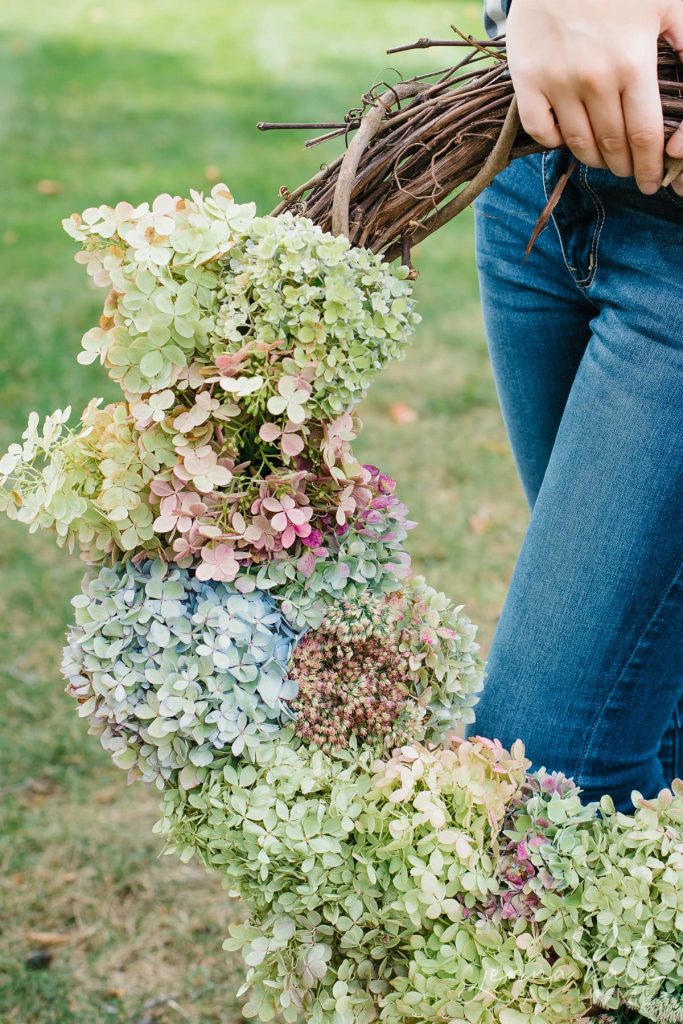
The Easiest Way to Make a Hydrangea Wreath
For more information about taking care of your landscape, please visit our other articles on landscaping with hydrangeas, and also butterfly bush varieties and care.
More than being a beautiful flowering plant that can grow in partial shade, hydrangeas have medicinal benefits that improve health! We’ve included some info on that in this shade tolerant hydrangeas article as well.
Here’s a link to the updated version of the pruning book Coleman has used for decades, formerly published by The Royal Horticultural Society, it’s now put out by DK:

Contributions from the Community
I have tried pruning in the fall and in the spring and over the years have learned toward the spring. This adds to interest in the yard in the winter and protection for wildlife. I shape, take out deadwood and for the most part prune just above new leaf buds.
I have 9 hydrangea bushes throughout my yard and enjoy their blooms all summer, both outside and with cut flower arrangements inside. When they start getting too heavy with blooms. I cut the blooms and dry them in a bucket in my garage for use in dried flower arrangements or wreaths.
~Carol Amoia
If you’re growing squash, you may also enjoy this article on pruning squash plants.
We are an online gardening publication sharing all things garden related! Including urban farming, family gardening, homesteading, gardening for profits, and more. We’re all about growth!

